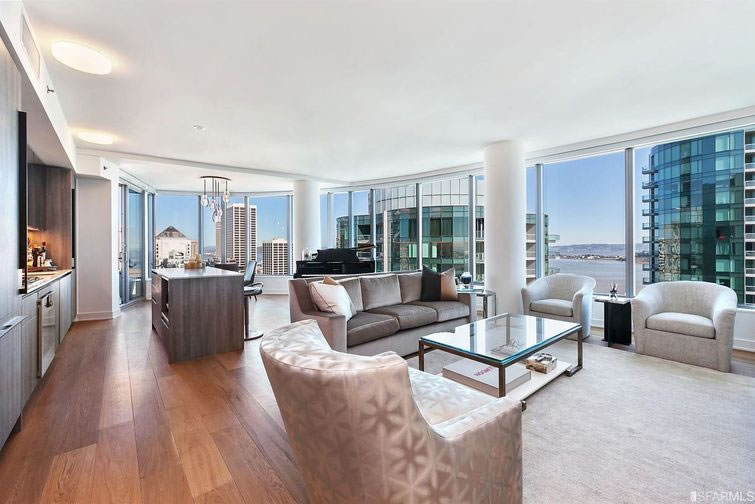Purchased from the sales office for $3,149,500, or roughly $2,003 per square foot, back in June of 2016, the “highest and largest” two-bedroom, two-bath unit in the Lumina tower at 338 Main Street, unit #35A, was then listed for $3,449,000 in March of 2017 while alternatively being offered for rent at $15,000 a month.
Reduced to $3,199,000 and then to $2,995,000 in May of 2017, 338 Main Street #D35A was relisted anew for “$2,900,000” in November of 2017 but then withdrawn from the market when an acceptable offer failed to materialize.
Listed anew for $3,299,000 early last year, perhaps in anticipation of a mis-projected wave of millionaires that were going to “eat San Francisco alive,” the unsold 1,572-square-foot unit was then listed for rent at $11,000 a month (which was reduced to $10,500 after a week). And in October of last year, the unit was listed anew for $3,150,000 and its days on the market were reset to “1.”
Reduced to $2,995,000 this past February, and then offered for rent at $9,000 a month in March, the list price for 338 Main Street #35A, the listing for which touts “unparalleled views of the Bay Bridge, water, city skyline & Twin Peaks,” along with “one of the most desirable floor plans at The Lumina,” is now down to $2,875,000, or roughly $1,830 per square foot, a sale at which would be 8.7 percent below the unit’s mid-2016 value on an apples-to-apples basis.
And for those running the numbers at home, the HOA dues for the unit have been running around $1,200 a month.






Freefall coming, look out below. This is a better sport than anything the leagues can ever offer.
Happens every time with these new sale releases. Price discovery is opaque and the initial buyer ends up overpaying from the developer sales team. Even without the pandemic, $2000 a foot for an average unit in the building (with barely space for a small dining table) is crazy considering penthouse resales at other nearby buildings rarely if ever hit that mark. Add a pandemic and I would expect this unit to trade in the $1500 foot range under a best case scenario after more months of marketing.
“Price discovery is opaque”. Exactly. You never know what your future neighborors have gotten in terms of free upgrades, “furniture allowances”, and subsidized HOA payments for a period of time. I would much rather buy on the secondary market and have the benefit of comparative market data from the MLS. Suckers pay a premium for the “new condo smell.”
New construction units are frequently flipped at a profit, at least when the market is appreciating.
It’s when the market has already started to turn, despite protestations to the contrary, that the flips become flops.
I agree with you that buying from builder is a profitable move in most cases.
The issue is the area. Buying in that general SOMA area is like competing in a beauty pageant – next year, there is going to be someone newer and younger. You can’t win forever. I have a friend who bought in 188 Minna (St Regis) many years ago, doubt anyone who bought there made any money…
When there is a shortage of product to buy, this might make sense. At the moment, there are plenty of homes for sale in the City between $2.5 and $3.5 million. It seems crazy to say this but you can get a lot more for your money in the northeastern neighborhoods.
In a recent SF Business Times article Jennifer Stojkovic paints a sobering outlook in which she says SF’s run as a tech center could be over with all the implications that has for everything from commercial office space to residential real estate: “Now, unsurprisingly, both residential and commercial San Francisco leases are being broken at an unprecedented rate with double-digit rent drops.” She questions those who fall back on SF’s history as a city of transients which goes through boom and bust cycles And that another boom is inevitable.
Whatever happens, SOMA would/will be particularly hard hit. With no HSR and fewer workers/restaurants/small businesses what is the draw to live there? Ms. Stojkovic mentioned the reaction of the City PTB – raise taxes. If the ballot tax increases are passed SF’s tech tax will be double that of Seattle. Giving tech employers another reason to exit San Francisco. Also, at a time when even NYC is cutting back on its bloated payroll, SF is not paring back but going into its emergency fund to give City employees raises. 40% of City employees make 150K factoring in benefits. The waste of money by the City may have been sustainable during the tech boom but it is no longer so. Still, the City PTB don’t get it.
SOMA? Further significant price drops are inevitable for condos as well as rent drops for apartments.
SOMA was the hardest hit in 2009~2012 cycle….
Actually, it wasn’t. Single-family home values in the “value” neighborhoods (Bayview, Ingleside, Oceanview, Excelsior and Portola) all dropped more, on a price per square foot basis, than SoMA condos. And while condo values in SoMa did drop around 22 percent on a price per square foot basis, that’s only 3 points higher than the average citywide drop, including single-family homes.
All of which brings us back to the actual unit and trend(s) at hand…
Don’t assume this is a repeat of that cycle. Things are different this time because of the changing work patterns. Less need/desire to house large groups of worker bee level techies in vey expensive downtown office space. That was a key point of the article. The author feels as I do that SF will not come back as the tech center it once was and that should drive RE investors – I believe you are one – in their decisions to purchase in SF or to hang onto their SF investment properties.
Nobody knows what future work patterns will be. Keep on pontificating about how “San Francisco is dead” and “this is the big one”, but the major investors don’t believe that is so. Seattle is having issues and so is New York. Long-term, a lot of people like living in cities and it would be foolish to bet against them. Much of the economy is organized for people to live and work in close proximity and, teleworking notwithstanding, I believe that most of us who do office work will return those offices at least a couple of days a week when this is over.
A hundred years ago, there was a terrible pandemic and it was followed by the Roaring-20s. People on the Asian continent have been living with disease outbreaks for years and their cities keep getting bigger (they have adjusted to wearing masks, as needed). Your argument, viewed in the larger historical, economic, and social context is not convincing.
“paints a sobering outlook in which she says SF’s run as a tech center could be over with all the implications that has for everything from commercial office space to residential real estate”
That seems way overblown. There is undoubtedly a shift to remote work/secondary hubs going on that will have a significant effect on Bay Area real estate. But that doesn’t mean an absolute shift that will end the Bay Area as a tech center. After all, as residential & commercial prices drop, the cost savings to employees and employers of moving away drops as well.
The last cycle from 2008-2018 was 10 years. This one seems much more severe so I think we are in for a longer cycle, maybe 12-15 years, but I think its still a cycle. Not the beginning of a continuous decline. The remote/secondary hub trend probably means the next peak won’t be as high as the last, but I don’t think it will end the bay area as a tech center.
The author was speaking of SF specifically. She was not saying the SV would lose its position as a tech center. Remember, tech started in the SV and the overflow with time came up the Peninsula and into SF.
guess: will sell for $2.49M
Sweat Equity indeed. At least the Truckee mansion is contingent.
Right now I can EASILY find a condo in SF and pay 10% less than what the previous owner paid in 2016-2019. People who think this drop will not hit +20% are completely delusional.
Absolutely, and 20% is low. Oil is trading at prices from 1990s, look at GE stock, Wells Fargo. I’d say first support for SF real state is 2002 prices. Prove me I’m wrong.
What does the price of Oil and GE’s stock (headquartered in Boston) have to do with SF real estate prices?
“What does the price of Oil and GE’s stock (headquartered in Boston) have to do with SF real estate prices?”
It suggests that the major, long-term, driving trend at work is deflation.
In a world of global quantitative easing and near-ZIRP, there are still *nominal* prices for everyday goods that are level with their 80s and 90s prices. Never mind inflation-adjusted prices …
We are doing everything we can – everything and the proverbial kitchen sink – and still just barely treading water.
Some stocks are more profitable than others. I have thousands of shares of NVDA that I paid on average $13.60 for. They trade for $554.38 a share as I write this…..
“Easily” Probably, sure. But they’re going to be less than desireable locations (even in “good” neighborhoods) and they’ll probably be drab mid-century stock (I’m talking non-SoMa neighborhoods).
I’d wait… I bought a condo in 2011 that I paid 61% less than the last buyer paid in 2007.
UPDATE: Value of Prized View Condo Drops $500K